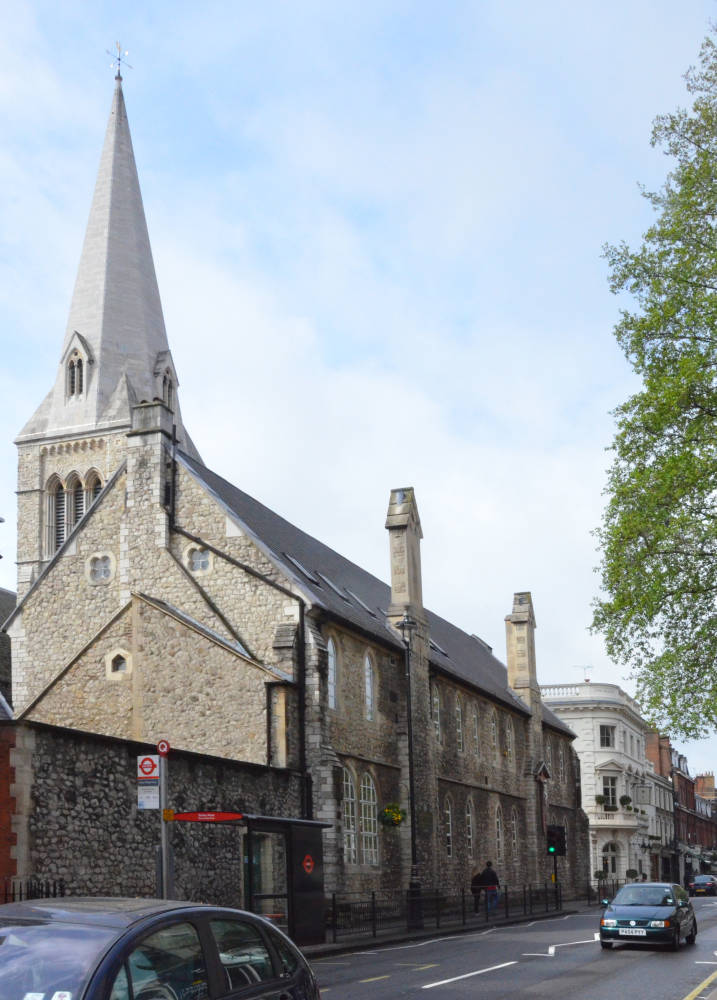




St. Barnabas, a magnet for controversy in 1850
St. Barnabas Church, St. Barnabas Street, Pimlico, London SW1W 8PF, a Grade I listed building (NGR: TQ2841378446), was designed by Thomas Cundy assisted by William Butterfield, constructed between 1847 and 1850, and consecrated on St. Barnabas Day, 11 June 1850.
The building has the singular importance of being “the first purpose-built church to embody the principles of the Oxford Movement, a tradition which it continues to maintain” (Diocese of London site). As “A Short Guide to St. Barnabas's Church, Pimlico” — a four-page information sheet available at the church — points out, St. Barnabas was “the first church built in England where the ideals and beliefs of what came to be known as [the] Anglo-Catholic movement were embodied in its architecture and liturgy.” As a pioneering church building thus embodying the doctrines of a then-controversial movement, it opened “amid considerable controversy caused by accusations of ‘Popery in Pimlico’” (“Guide”) prompted in part because in the very year St. Barnabas saw completion, the Roman Catholic Church re-established diocesan and parish organization for the first time since the sixteenth century. As Anthony Wohl explains elsewhere on this site,
although Catholics had long enjoyed toleration in England [the Catholic Emancipation Bill passed in 1829], their church was governed by vicars apostolic rather than bishops and there was no diocesan or parish organization. But in 1850, partly to better administer to the large number of Catholic Irish flocking into England after the Irish Famine, the Catholic Church re-established its full hierarchy. For the first time since the reign of Mary Tudor (1555-1558), Catholics now had a a full hierarchy consistent with that of Catholic countries. Thirteen sees and the archdiocese of Westminster were established.
To liberals the re-establishment of the Catholic hierarchy in England was but a logical extension of toleration and full religious liberties, but to many other Englishmen it marked yet another disastrous concession to the "Bishop of Rome" and yet another sign that the Church of England, convulsed by the high ritualism and Anglo-Catholicism of the Oxford Movement and still reeling from the recent conversion to Catholicism of the eminent Anglican theologian, John Henry Newman, was in retreat before its old adversary, the Catholic Church. . . .
The re-establishment of the Catholic hierarchy thus occurred at a most critical time and raised many questions. Did the new Catholic Archbishop, with his archdiocese in London, take diplomatic precedence over the Bishop of London? What was his diplomatic status as a Cardinal? Should the English permit the Catholic Church full powers to proselytize and convert? Did the new recognition of the Catholic Church mean that all the qualifying clauses which accompanied the Catholic Emancipation Act of 1829) were now in abeyance? [“The Re-establishment of the Catholic Hierarchy in England, 1850”]
The role of St. Barnabas in Victorian Pimlico
St. Barnabas has particular historical importance not only because it pioneered the architectural embodiment of Anglo-Catholic liturgy but also because it was designed as a center of social services in a poor community. St. Barnabas therefore included an orphanage, a boy's school, a refuge for former prostitutes, and residences for the numerous clergymen who provided these services. According to Mr. John Boshier, the knowledgable and enthusiastic guide who assists vistors to the church, when the Rev. William Bennett, then Vicar of St. Paul's Knightsbridge, approached the owner of the land to request its use for a church, he was asked exactly what he intended to do with it, upon which he explained his plans to serve the community. The landowner was so impressed, he gave the land outright. The primary school, now co-educational, still exists, but St. Barnabas’s Church now opens only for low mass on Wednesday and High Mass on Sunday, and the orphanage and refuge for fallen women are long gone, as is the residence for the young clergy, which has now been turned into private flats. The church is open Saturdays between 10 am and 3 pm, and is well worth a visit. — George P. Landow
Photographs of the building
- The exterior of St. Barnabas
- The Chancel and Sanctuary
- The Organ
- Full-length statues of saints and the Madonna
- Miscellaneous carvings in wood and stone
- The Pulpit
- Baptistery and Font
- Chapel of St. John the Baptist
- Stained glass by Kempe and Tower
- Stained glass by Sir Ninian Comper
- Mosaics in the church
Other major Trinitarian churches
References
“A Short Guide to St. Barnabas's Church, Pimlico.” Four-page guide available at the church.
St Barnabas Pimlico (church website). 20 April 2015.
Last modified 27 April 2015